InterWorks just had our company summit a few weeks ago, and we had some hands-on training with ThoughtSpot. We are seeing so many clients who have multiple BI platforms and we want to know everything we can about how we can all get stronger in our knowledge. We asked a number of the InterWorks consultants who went through the training to share their thoughts and their work, which you can find below.
This discussion was facilitated by Matt Phillips and Josh Royse from ThoughtSpot who joined us at our company summit for the week as honorary InterWorks team members.
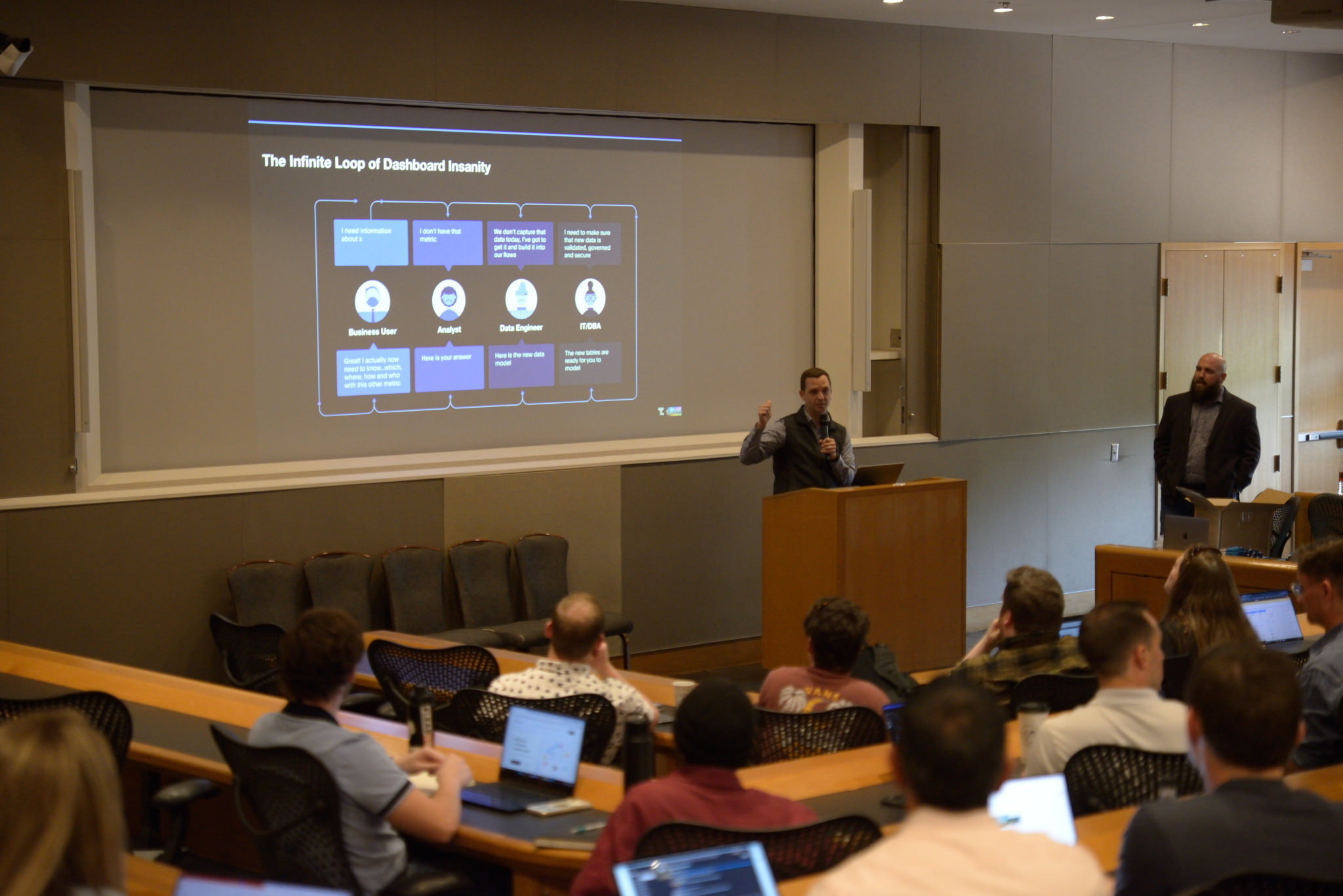
Above: Matt Phillips presenting and Josh Royse helping facilitate a live workshop.
Our consultants had 15 minutes to run through an exercise and were asked to share their results with their fellow consultants and discuss the experience together. Here’s a bit of what they had to say:
As a more veteran ThoughtSpot user, I loved seeing the diverse backgrounds of individuals at InterWorks who were interested in seeing what ThoughtSpot has to offer. We had representation from our BI consultants, data engineers, strategists, sales team and more, all curious about how they could leverage ThoughtSpot’s Natural Language Search features to make the lives of their clients (and their own) easier. In just a short demo, the ThoughtSpot team was able to show the speed to value that organizations can recognize with the search experience. Josh exemplified how a user could use tokenized keywords and natural language to answer a business question that may have previously required an analyst writing complex SQL to answer. Not only did they show the power of no-code data retrieval, but also the quality of visualization generated with these answers and how low-effort they were to create. The excitement around ThoughtSpot and search analytics is irrefutable at InterWorks, I can’t wait to see how we can continue to provide value to clients and our own internal users with the ThoughtSpot Sage feature.
Matt and Josh did an excellent job presenting about ThoughtSpot to our team. Matt lead with the value aspect and the use cases that ThoughtSpot makes the most sense for. Josh then came behind him with more of the technical aspect and how to use the tool. He really emphasized the ease of use even with all its capabilities. In the second half of the session, we got a chance to get our hands dirty and dive into the tool. We were given a set of data and then prompted to answer a question using to the tool to analyze the data. I was afraid I would struggle with my lack of technical background, but the natural language component and intuitiveness of the tool really made it easy to navigate and get to where I wanted to go.

Above: Connor watching the ThoughtSpot presentation.
Alfonso Vaca-Lubischer:
Throughout my undergraduate and graduate programs, I’ve always thought the best classes I’ve taken are those that produce more questions than answers—questions that stem from rabid curiosity and not confusion. These are courses that open my eyes to a vast new field of study or work and tease me with just enough content to know how to ask for more. I experienced this very feeling when Matt and Josh presented ThoughtSpot to InterWorks.
At first, I was skeptical. I’ve heard of ThoughtSpot before and one of the main comments is that the tool is not like Google for your data—you can’t haphazardly type in a question in a search bar, expecting the tool to understand your misspelled ask. Instead, I heard it requires some training on how to ask for things. How is this much different from Tableau or other BI tools, then? In showing us how the tool works, from a demo to a hands-on training, Matt and Josh answered this question for me. Although it was a brief session, I learned enough about the tool to build my first Liveboard and answer some basic prompts (e.g. the fastest growing and top selling products). While at first it didn’t seem like the most intuitive tool (certain phrases had to be written in a specific way), I quickly realized how powerful it can be, particularly for quick, ad hoc analyses. These off-the-cuff analyses are not an insignificant portion of a business’ operations. In fact, efficient operations require quick answers to very niche questions, and, currently, there are limited, suboptimal ways to get these answers:
- The technical (write some custom SQL)
- The tedious (open an Excel sheet)
- The bureaucratic (delegate the task to analysts and data engineers)
- The abominable (open a congested dashboard that tries to answer all the questions)
This is the gap I think ThoughtSpot is here to fill, and I am very much here for it, both for what it has to offer now and what is yet to come. Matt and Josh were very aware and transparent about the various shortcomings of the tool, and while it is impressive as it is, ThoughtSpot is still in the ramp up phase. Many of our questions around the capabilities of the tool were met with, “Not yet” and, “It’s coming!” It is a truly exciting time to engage with this tool, especially with major breakthroughs visible on the horizon, such as ThoughtSpot Sage. Overall, I came out of that session with a whole lot more questions than answers, questions around the future of business intelligence, the applicability of this tool for my clients and the new realm of possibilities around search-driven analytics.
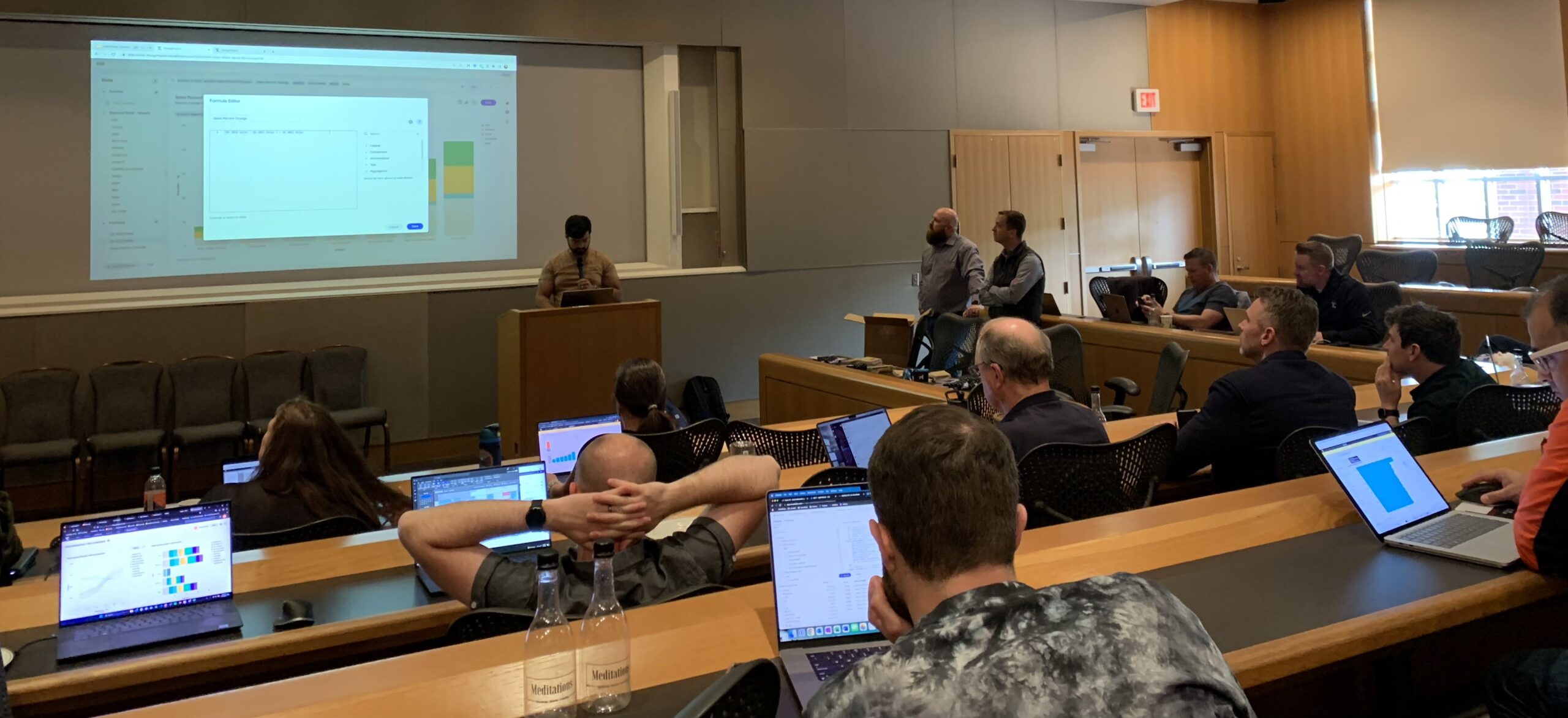
Above: Alfonso presenting his work in front of the group.
Chris Chang:
I wanted to share my raw, unfiltered notes from right after the ThoughtSpot Demo, so you can get a glimpse into how I felt in the most direct form possible:
- Search function can be more intuitive to nontechnical users.
- Search is closer to Amazon search than Google search; overall not the natural language search you would fully expect.
 Above: A line graph generated by searching “sales” and “by month.”
Above: A line graph generated by searching “sales” and “by month.”
-
- Great for allowing end users to learn high level information within the data and can save developers/data engineers time from having to pull simple ad hoc questions.
- Has its own semantics and keywords that users of all types will need to learn.
- In general, you need to know what you want to search and look to see what columns exist in your table to search.
- To test, I had a fully nontechnical user try out the tool with no experience with the data and no instructions. User impressed by visuals that could be generated from query but felt they would need more training and more validation process to feel more confident and less restrained when trying to investigate/understand the data set.
- Data prep needs to be done before connecting to ThoughtSpot.
- Can create data source security through grouping using an Admin features.
- Clean data helps eliminate basic aggregation questions by adding in a layer of validation before users can query.
- If you have simple questions, you can get an answer fast.
- The more complex the question, the more complex the search/key terms will get.
- There needs to be a process/system/validation in place to ensure that the right questions and answers are contextually appropriate.
- Ex: TS demo question was what products we should focus on in the next coming quarters. Many people tried to answer this from a sales/profit/growth perspective. Some answered the question looking at products with the highest sales of all time, some looked at the past few months. The sales data overall looked cyclical, so growth in any isolated time period could be misleading.
- One word of caution is if a nontechnical/nonanalytical user is using ThoughtSpot to answer a question, then they could get a “bad” (not necessarily wrong) answer to their question because context matters.
- Bad answers always exist in analytics, but I think because ThoughtSpot has the potential to open up the pool of end users, it could become even more common here without the right governance/validation steps in place.
- More Flexibility for end user drill downs compared to other BI tools out there.
- Developers usually need to predict/build user drill downs.
- ThoughtSpot allows end users to create their own path and discover their own insights.
- Deeper/more complicated analytics will still require ThoughtSpot developers to write the key terms in the “search” using proper syntax.
- You can write subqueries using “IN,” but it can get complicated and I would not expect an end user to be able to write something like that.
- Sample of search to get top five item types by quarter over time:
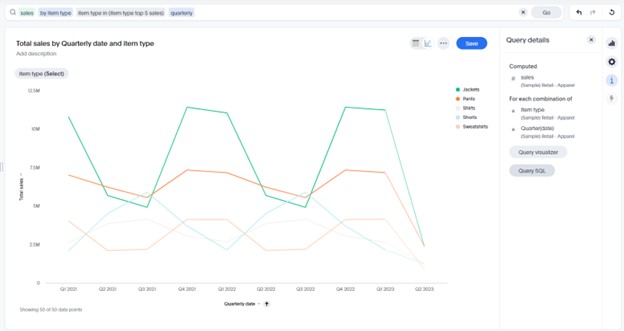
Additionally, we asked some other consultants to share some screenshots of the liveboards they built over that 15 minute sprint during the presentation. Take a look here!
Randy Castillo’s liveboard:
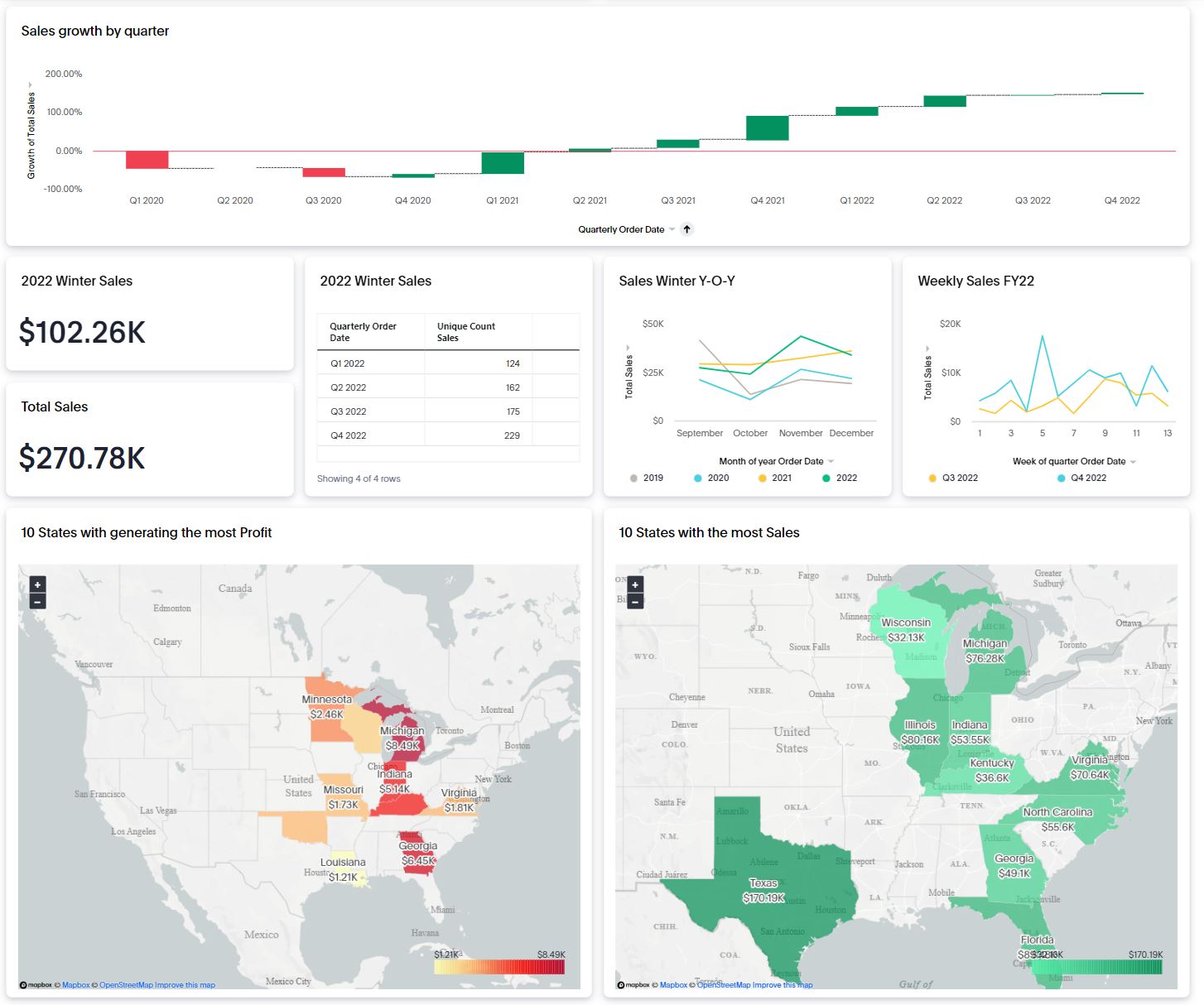
Karinna Spitalnick’s liveboard:
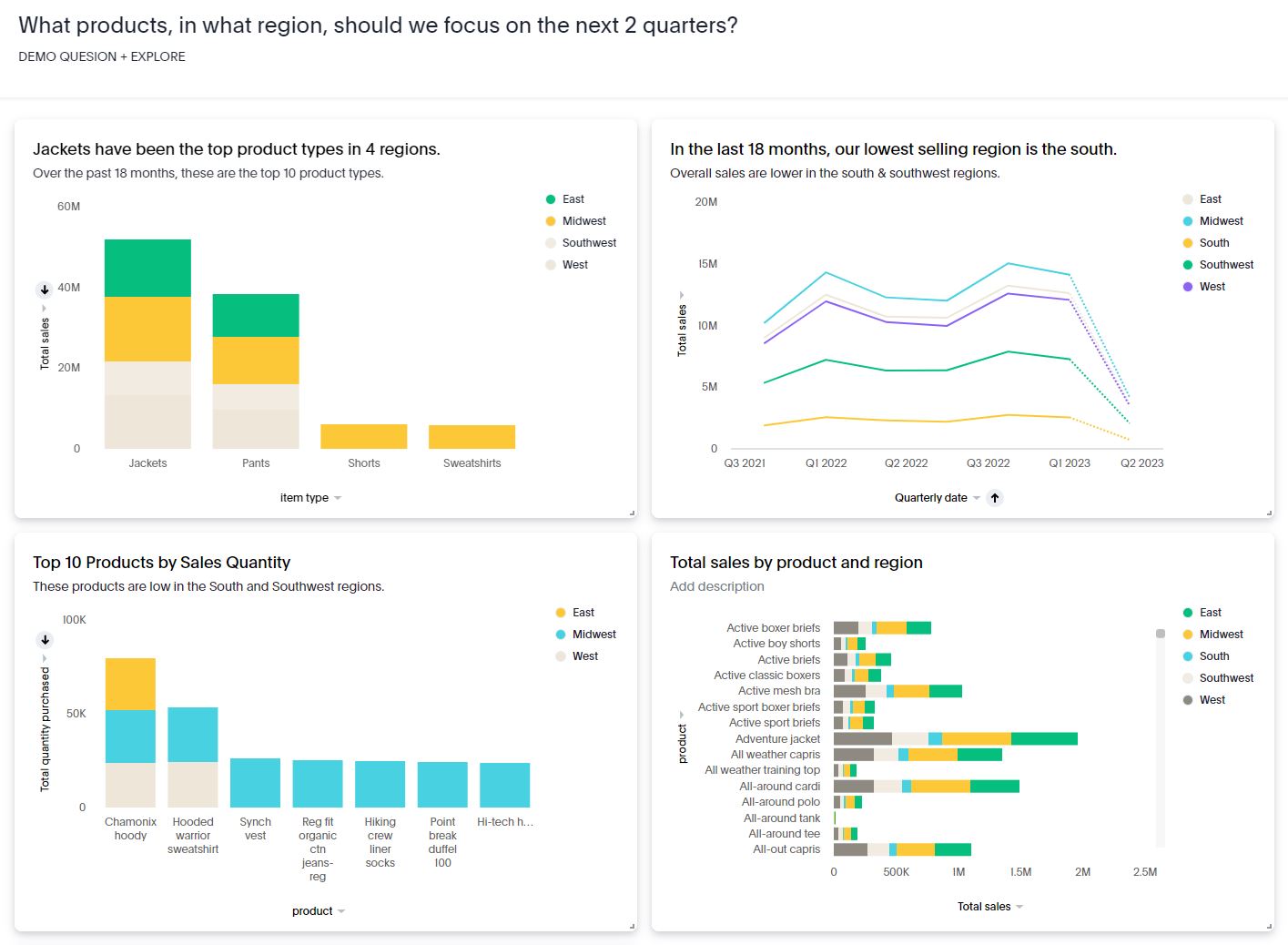
Robby White’s liveboard:
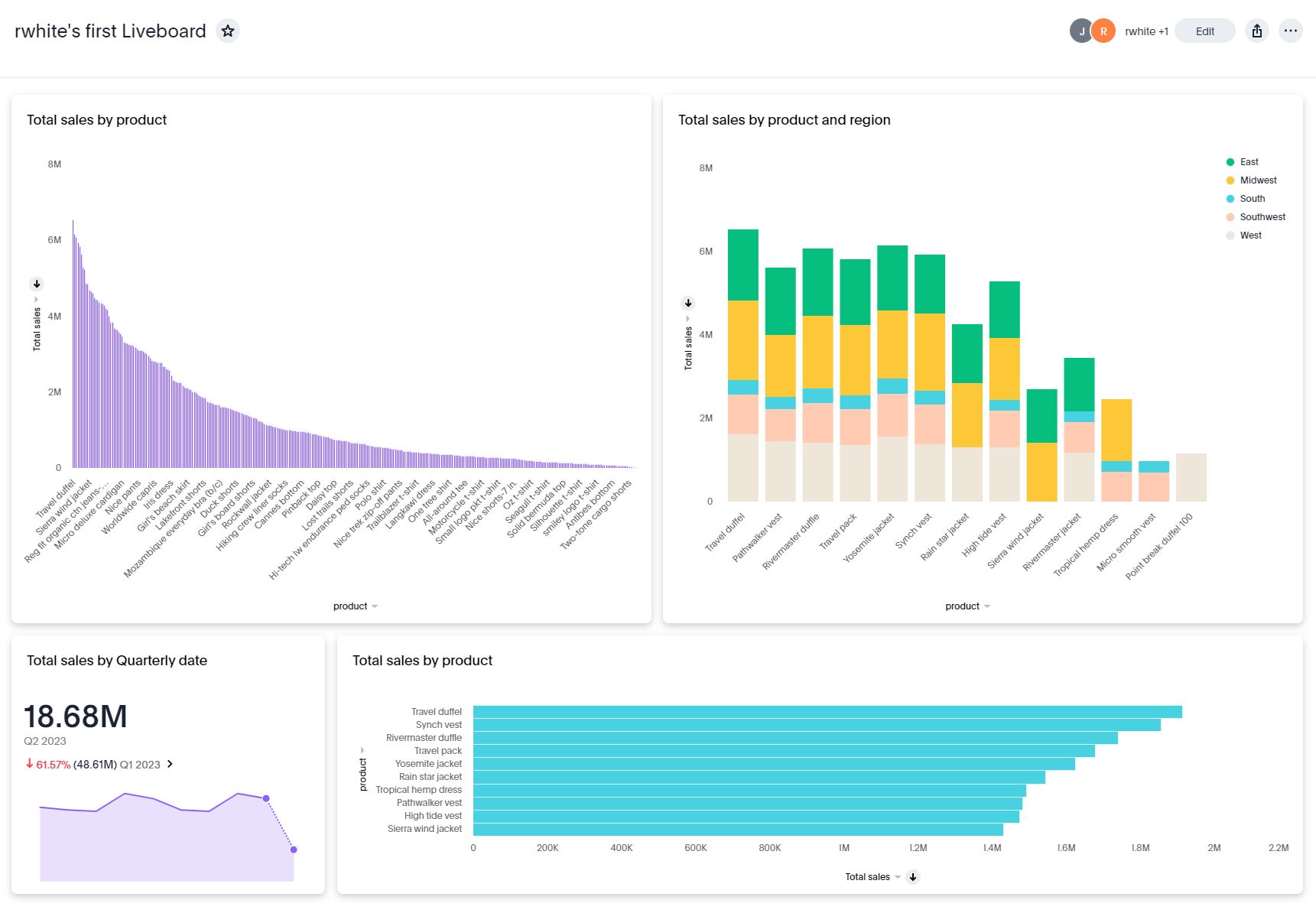
In the end, our Tableau-focused consultants that attended the training walked away with a newfound appreciation for the advantages that come with having multiple BI tools in your arsenal. If you’re interested in doing a free trial of ThoughtSpot, they’ve graciously provided us with a link to a free trial that you can access today to see the advantages ThoughtSpot brings to the table.
Speaking of free things surrounding ThoughtSpot, keep an eye on our events page! We’ll be doing a webinar in June titled ThoughtSpot: Use Cases for Search Analytics. So, if you want a guiding hand while walking through the tool, feel free to tune in live or just go ahead and register. We’ll send a replay email to anyone who does, so you can catch up whenever’s convenient if you can’t make the live presentation. If you want to work with us directly on ThoughtSpot, you can alway drop us a line and we’d be more than happy to assist!
Last thing, I promise: Check out our YouTube channel, where we have some quick videos on ThoughtSpot demos you might find interesting.
All right, that’s all the links we have to share. Thanks for reading, and we hope we gave you some valuable perspective on ThoughtSpot!

